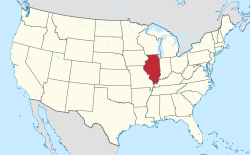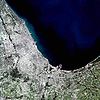world.wikisort.org - USA
Oakwood Hills is a village in McHenry County, Illinois, United States. Oakwood Hills was founded in 1959.[2] The population was 2,083 at the 2010 census. As of 2018, the population dropped to 2,041.[3]
This article uses bare URLs, which are uninformative and vulnerable to link rot. (August 2022) |
Oakwood Hills | |
|---|---|
Village | |
 Location of Oakwood Hills in McHenry County, Illinois. | |
 Location of Illinois in the United States | |
| Coordinates: 42°14′52″N 88°14′43″W | |
| Country | United States |
| State | Illinois |
| County | McHenry |
| Townships | Nunda, Algonquin |
| Founded | 1959 |
| Area | |
| • Total | 1.17 sq mi (3.04 km2) |
| • Land | 1.09 sq mi (2.82 km2) |
| • Water | 0.08 sq mi (0.22 km2) |
| Population (2020) | |
| • Total | 2,076 |
| • Density | 1,908.09/sq mi (736.58/km2) |
| Time zone | UTC-6 (CST) |
| • Summer (DST) | UTC-5 (CDT) |
| ZIP Code(s) | 60013 |
| Area code | 224 |
| FIPS code | 17-55041 |
| Wikimedia Commons | Oakwood Hills, Illinois |
| Website | http://www.oakwoodhills.org/ |
Geography
Oakwood Hills is located at 42°14′52″N 88°14′43″W (42.247658, -88.245176).[4]
According to the 2010 census, Oakwood Hills has a total area of 1.262 square miles (3.27 km2), of which 1.18 square miles (3.06 km2) (or 93.5%) is land and 0.082 square miles (0.21 km2) (or 6.5%) is water.[5]
Demographics
| Historical population | |||
|---|---|---|---|
| Census | Pop. | %± | |
| 1960 | 213 | — | |
| 1970 | 476 | 123.5% | |
| 1980 | 1,255 | 163.7% | |
| 1990 | 1,498 | 19.4% | |
| 2000 | 2,194 | 46.5% | |
| 2010 | 2,083 | −5.1% | |
| 2020 | 2,076 | −0.3% | |
| U.S. Decennial Census[6] 2010[7] 2020[8] | |||
2020 census
| Race / Ethnicity | Pop 2010[7] | Pop 2020[8] | % 2010 | % 2020 |
|---|---|---|---|---|
| White alone (NH) | 1,931 | 1,731 | 92.70% | 83.38% |
| Black or African American alone (NH) | 4 | 15 | 0.19% | 0.72% |
| Native American or Alaska Native alone (NH) | 6 | 4 | 0.29% | 0.19% |
| Asian alone (NH) | 37 | 29 | 1.78% | 1.40% |
| Pacific Islander alone (NH) | 0 | 3 | 0.00% | 0.14% |
| Some Other Race alone (NH) | 3 | 13 | 0.14% | 0.63% |
| Mixed Race/Multi-Racial (NH) | 10 | 93 | 0.48% | 4.48% |
| Hispanic or Latino (any race) | 92 | 188 | 4.42% | 9.06% |
| Total | 2,083 | 2,076 | 100.00% | 100.00% |
Note: the US Census treats Hispanic/Latino as an ethnic category. This table excludes Latinos from the racial categories and assigns them to a separate category. Hispanics/Latinos can be of any race.
2000 Census
As of the census[9] of 2000, there were 2,194 people, 719 households, and 598 families residing in the village. The population density was 1,943.9 inhabitants per square mile (750.5/km2). There were 736 housing units at an average density of 652.1 per square mile (251.8/km2). The racial makeup of the village was 98.04% White, 0.36% African American, 0.23% Native American, 0.32% Asian, 0.18% from other races, and 0.87% from two or more races. Hispanic or Latino of any race were 3.37% of the population.
There were 719 households, out of which 47.8% had children under the age of 18 living with them, 73.2% were married couples living together, 6.8% had a female householder with no husband present, and 16.8% were non-families. 11.8% of all households were made up of individuals, and 2.2% had someone living alone who was 65 years of age or older. The average household size was 3.05 and the average family size was 3.34.
In the village, the population was spread out, with 31.5% under the age of 18, 7.1% from 18 to 24, 35.2% from 25 to 44, 22.3% from 45 to 64, and 3.9% who were 65 years of age or older. The median age was 34 years. For every 100 females, there were 102.4 males. For every 100 females age 18 and over, there were 99.9 males.
The median income for a household in the village was $68,182, and the median income for a family was $70,875. Males had a median income of $52,051 versus $30,508 for females. The per capita income for the village was $26,397. About 3.9% of families and 5.0% of the population were below the poverty line, including 4.2% of those under age 18 and 4.3% of those age 65 or over.
Proposed Natural Gas Power Plant
This section needs additional citations for verification. (March 2016) |
During the summer of 2014, the residents of Oakwood Hills and surrounding communities voiced their concerns about the creation of a power plant, by Northland Power and Enventure Partners,[10] on property just north of the village. A group of concerned citizens hired expert Robert G. Abboud to create an impact assessment of the proposed project. The report emphasized risks to groundwater, air quality, and noise issues, among others as to why the project needed to be further studied.
See also
- Crystal Lake, Illinois
- Cary, Illinois
- Prairie Grove, Illinois
- Silver Lake, Illinois
- Lake Killarney
References
- "2020 U.S. Gazetteer Files". United States Census Bureau. Retrieved March 15, 2022.
- Pfannkuche, Craig L. "Oakwood Hills, Illinois". Encyclopedia of Chicago. Retrieved 26 July 2016.
- "U.S. Census website". United States Census Bureau. Retrieved October 18, 2015. American FactFinder, U.S. Census Bureau. Retrieved 28 January 2014.
- "US Gazetteer files: 2010, 2000, and 1990". United States Census Bureau. 2011-02-12. Retrieved 2011-04-23.
- "G001 - Geographic Identifiers - 2010 Census Summary File 1". United States Census Bureau. Archived from the original on 2020-02-13. Retrieved 2015-12-25.
- "Decennial Census of Population and Housing by Decades". US Census Bureau.
- "P2 HISPANIC OR LATINO, AND NOT HISPANIC OR LATINO BY RACE – 2010: DEC Redistricting Data (PL 94-171) – Oakwood Hills village, Illinois". United States Census Bureau.
- "P2 HISPANIC OR LATINO, AND NOT HISPANIC OR LATINO BY RACE – 2020: DEC Redistricting Data (PL 94-171) – Oakwood Hills village, Illinois". United States Census Bureau.
- "U.S. Census website". United States Census Bureau. Retrieved 2008-01-31.
- http://enventurepartners.com
External links
Другой контент может иметь иную лицензию. Перед использованием материалов сайта WikiSort.org внимательно изучите правила лицензирования конкретных элементов наполнения сайта.
WikiSort.org - проект по пересортировке и дополнению контента Википедии

